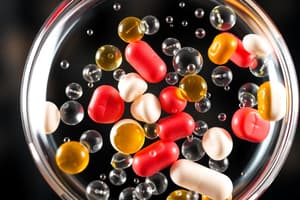Podcast
Questions and Answers
What does pharmacokinetics primarily study?
What does pharmacokinetics primarily study?
- The synthesis of drugs
- The effects of drugs on the body
- The chemical structure of drugs
- The body's processes related to a drug (correct)
Which route of administration is NOT classified as enteral?
Which route of administration is NOT classified as enteral?
- Intravenous (correct)
- Oral
- Sublingual
- Rectal
In zero-order kinetics, how is the rate of elimination affected by drug concentration?
In zero-order kinetics, how is the rate of elimination affected by drug concentration?
- It remains constant regardless of concentration (correct)
- It decreases with higher concentrations
- It varies unpredictably with concentration
- It increases with higher concentrations
What is the main characteristic of first-order kinetics regarding drug elimination?
What is the main characteristic of first-order kinetics regarding drug elimination?
What is necessary to use the Henderson Hasselbalch equation effectively?
What is necessary to use the Henderson Hasselbalch equation effectively?
Flashcards
Pharmacokinetics
Pharmacokinetics
The study of how the body processes a drug, including absorption, distribution, metabolism, and elimination.
Routes of Administration: Enteral
Routes of Administration: Enteral
Drug delivery methods where the medication enters the body through the digestive system.
Routes of Administration: Parenteral
Routes of Administration: Parenteral
Drug delivery methods that bypass the digestive system.
Zero-Order Kinetics
Zero-Order Kinetics
Signup and view all the flashcards
First-Order Kinetics
First-Order Kinetics
Signup and view all the flashcards
Study Notes
Pharmacokinetics
- Pharmacokinetics is the study of what the body does to a drug.
- It describes the changing concentrations or amounts of a drug and its metabolites in blood, plasma, urine, and other body tissues and fluids.
- Key processes include:
- Absorption
- Distribution
- Metabolism
- Excretion (ADME)
Routes of Drug Administration (RofA)
- Absorption is how the body takes in a drug.
- Enteral routes:
- Oral (swallowed)
- Sublingual (under the tongue)
- Buccal (between cheek and gum)
- Rectal (inserted into rectum)
- Parenteral routes:
- Intravenous (IV)
- Intramuscular (IM)
- Subcutaneous (SQ/SC)
- Inhalation
- Epidural
- Intra-articular
- Topical/Transdermal (applied to skin or mucous membrane)
- Ocular
- Otic (into the ear)
- Parenteral (bypassing gut, often requiring injection)
Bioavailability (F)
- Bioavailability quantifies the fraction of a drug that reaches systemic circulation after administration.
- IV administration has 100% bioavailability because it bypasses absorption.
- Oral administration has less than 100% bioavailability due to first-pass metabolism (metabolism in the liver before reaching systemic circulation).
- Other factors impacting bioavailability include:
- incomplete absorption
- gastric acid
- enzymatic destruction
- intestinal barriers
First-Pass Metabolism
- First-pass metabolism refers to drug metabolism in the liver before reaching systemic circulation.
- This process can significantly impact the therapeutic effect of a drug, often reducing its bioavailability when administered orally.
Oral Ingestion (Absorption)
- Absorption is governed by factors such as:
- surface area for absorption in the intestine
- blood flow
- drug concentration
- physical state of drug
- Occurs primarily via passive diffusion.
- In theory, weak acids are best absorbed in the stomach, and weak bases are best absorbed in the intestines.
- In reality however absorption is greater in the intestines due to surface area and organ function.
- Form of oral drugs affects rate of absorption:
- Liquids (syrups, elixirs) are the fastest
- Powders are rapid
- Pills/Capsules are the slowest.
Rate of Appearance in Blood
- Affected by rate of dissolution and absorption from the GI tract.
- Timed-release or enteric-coated pills alter the rate at which the drug appears in the blood.
Effect of Changing Rate of Gastric Emptying
- Cold water ingestion accelerates gastric emptying, leading to increased drug absorption.
- Fatty meals and other factors can slow gastric emptying.
Rectal Administration
- Useful for vomiting or unconscious patients.
- Approx. 50% of the drug bypasses the liver.
- Disadvantages include irregular/incomplete absorption, irritation, and patient aversion.
Sublingual Administration
- Absorption from the oral mucosa has significance for drugs like nitroglycerin.
- This route bypasses first-pass metabolism.
Subcutaneous Administration
- Slow and constant absorption.
- Suitable for slow-release pellets.
- Needs non-irritating drugs.
Intramuscular Administration
- Rapid absorption from aqueous solutions, with rates varying among muscle groups (e.g., gluteus, deltoid).
- Slow absorption with oil-based solutions or suspensions.
Intra-arterial Administration
- Used to target a drug to a specific organ (e.g., for tumors, cancers).
- Requires specialized expertise/experience, is usually reserved for a limited number of cases.
Intrathecal Administration
- Necessary when blood-brain or blood-CSF barriers are present.
- Injection into spinal subarachnoid space.
- Used in spinal anesthesia for acute CNS infections.
Intraperitoneal Administration
- Peritoneal cavity offers large surface area for absorption.
- Seldom used clinically due to high infection risk.
Pulmonary Absorption
- Used for inhaled gaseous and volatile drugs.
- Almost instantaneous absorption.
- Avoids first-pass metabolism.
Topical Application
- Used for mucous membranes (eye, nose, vagina etc).
- Intended for local effects.
- Systemic absorption (e.g., antidiuretic hormone through nasolacrimal canal) possible.
- Also used for skin application.
Topical Application (Skin)
- Limited number of drugs are absorbed.
- Absorption is proportional to the surface area and is increased with inflammation and abrasions.
- Oily vehicles enhance absorption by aiding penetration into the skin.
Topical Application (Eye)
- Often for local effects.
- Systemic absorption through the nasolacrimal canal is undesirable.
- Bypasses first-pass metabolism.
Molecular Size (Absorption)
- Smaller molecules diffuse more readily across cell membranes than larger ones, inversely proportional to square-root of molecular weight.
- This pertains to passive diffusion, and not to specialized transport mechanisms.
- Tight junctions have low molecular weight passage.
Lipid Solubility (Absorption)
- Lipid solubility (oil:water partition coefficient) is vital for crossing cell membranes.
- A more lipid-soluble drug will usually cross more readily.
Ionization (Absorption)
- Most drugs are weak electrolytes (acids/bases).
- The degree of ionization varies with pH.
- Non-ionized forms of drugs cross cell membranes more easily.
Ionization (2):
- Ionized form of drugs = polar = water-soluble.
- Non-ionized form = less polar = more lipid-soluble.
- pKa= Acid dissociation constant, at which 50% of the molecules are ionized.
Henderson-Hasselbalch Equation
- A relationship between pH, pKa, and the ratio of ionized/non-ionized forms.
Membrane Transfer
- Methods of drug movement across cell membranes include passive diffusion, carrier-mediated transport, active transport, pinocytosis and endocytosis.
Facilitated Diffusion
- Carrier-mediated process without energy requirement
- Movement can't be against the gradient
- Necessary for compounds to cross membranes by simple diffusion.
Special Carriers
- Important for transporting substances that are too large for simple diffusion.
- Examples include peptides, amino acids, and glucose.
- Saturable and inhibited transport mechanisms.
- Active transport requires energy. Facilitated diffusion does not.
Drug Absorption and Bioavailability
- Absorption describes how much/how quickly a drug leaves its administration site.
- Bioavailability (F) describes how much of a drug reaches its site of action or a biological fluid where it would have access to its target.
- Bioavailability is measured by the Area Under the Curve (AUC).
Factors Modifying Absorption
- Drug solubility
- Local conditions (pH, temperature)
- Local circulation.
- Surface area.
Bioequivalence
- Drugs are bioequivalent if they have similar rates and extents of bioavailability after administration, regardless of formulation.
- This is vital for different formulations of a drug to be interchangeable.
Distribution
- Once absorbed, drugs are distributed into interstitial and cellular fluids.
- The distribution pattern is influenced by physiological and physicochemical properties of the drug.
Phases of Distribution
- Initial phase: reflects cardiac output, mostly to heart, brain, liver, and kidney.
- Next phase: slower delivery to tissues like muscle, viscera, skin, and fat, involving a larger proportion of the body.
Drug Reservoirs
- Body areas accumulating drugs, like plasma proteins, cellular reservoirs (adipose, for lipid-soluble drugs), bone, or transcellular trapping (ion trapping).
- Dynamic impact on drug availability.
Protein Binding
- Drugs can bind to plasma proteins (e.g., albumin) or tissue proteins.
- Only unbound drug can diffuse across membranes.
Plasma Proteins
- Albumin and α1-acid glycoprotein are important binding proteins.
- Binding impact depend on the concentration of the protein, binding affinity, and the number of binding sites.
Plasma Proteins (2) Example
- Thyroxine (T4) is significantly bound to plasma proteins, particularly to thyroxine-binding globulin (TBG).
Bone Reservoir
- Tetracycline antibiotics and divalent metal ion-chelating agents can store in bone.
- Eventually incorporated into the crystal lattice, serving as a slow release reservoir.
Adipose Reservoir
- Lipid-soluble drugs are stored in fat tissue, which can act as a reservoir, especially in patients with high body fat content.
Thiopental
- Highly lipid-soluble intravenous anesthetic.
- Quickly distributed to brain, and subsequently to other tissues, like muscle.
- Rapid accumulation in fat.
- Can lead to slow elimination and potential prolonged effects.
GI Tract as Reservoir
- Weak bases can concentrate in stomach due to pH.
- Some drugs are excreted in bile and can be reabsorbed or are stored in the GI tract.
Placental Transfer
- Drugs cross the placenta via passive diffusion, mostly lipid soluble and non-ionized drugs.
- Transfer rates tend to increase toward term as tissue layers between maternal and fetal blood capillaries thin.
Clinical Pharmacokinetics
- A relationship exists between the pharmacological or toxic response to a drug and the accessible drug concentration in the blood.
- Important parameters are volume of distribution, clearance, and bioavailability.
Volume of Distribution
- Relates the amount of drug in the body to the plasma concentration.
- The apparent volume of distribution often doesn't correspond to a real anatomical space.
Total Body Water
- Compartments include plasma, interstitial, and intracellular fluids.
Elimination (Clearance)
- Clearance is the volume of blood or plasma cleared of drug during a time period.
- Affected by drug's concentration, and rate of elimination.
- Rates are usually constant (1st-order kinetics) and proportional to drug concentration.
Clearance (2)
- Clearance does not mean the drug is completely removed; rather, it represents the volume of blood cleared per unit time.
- The rate of elimination is directly proportional to the drug concentration.
Clearance (3) / (4) / (5) Examples
- Different drug clearance example are given.
Clearance in Organ
- Rate of elimination = blood flow to organ X (arterial drug concentration minus venous drug concentration)
Kinetics of Drug Elimination
- Zero-order kinetics shows a constant rate of removal.
- First-order kinetics displays proportional removal with decreasing concentration.
Studying That Suits You
Use AI to generate personalized quizzes and flashcards to suit your learning preferences.





